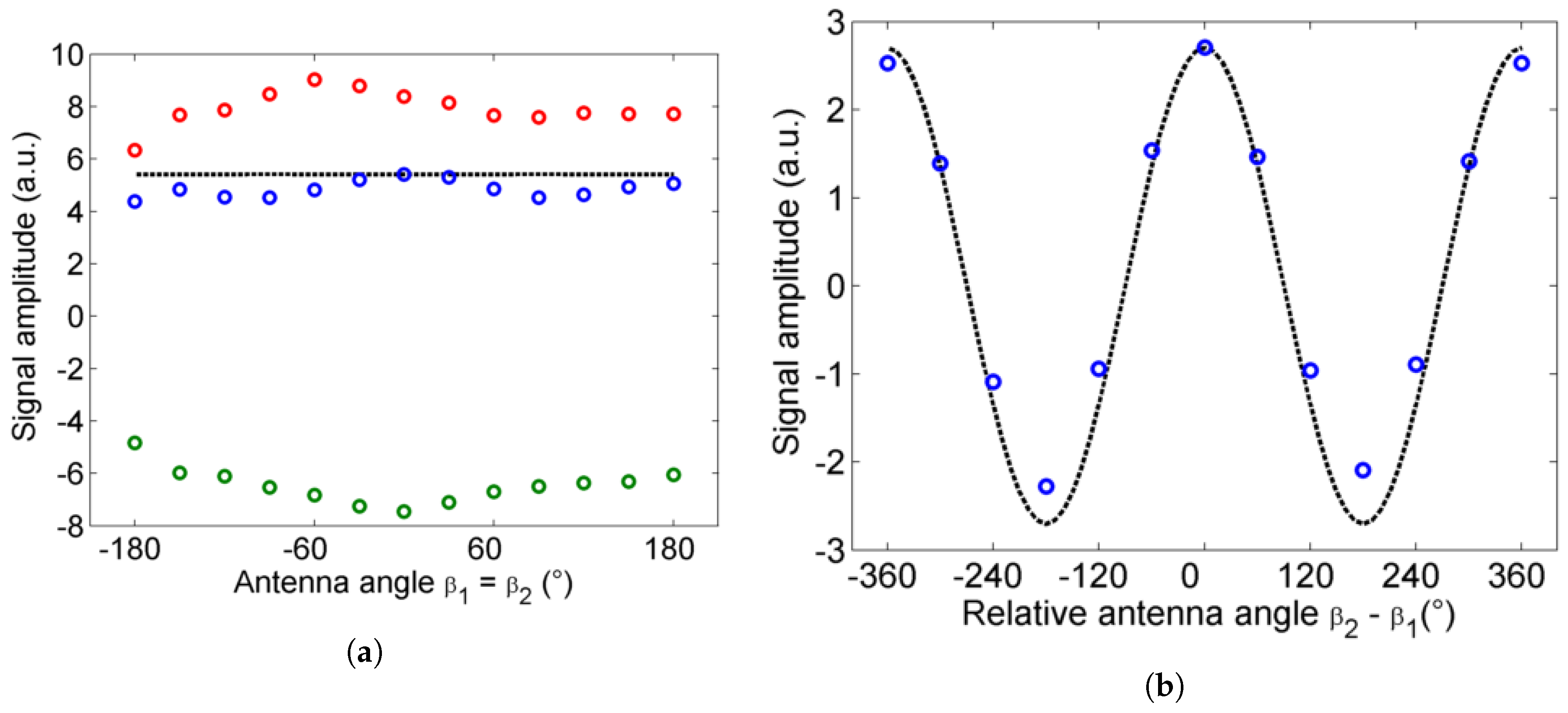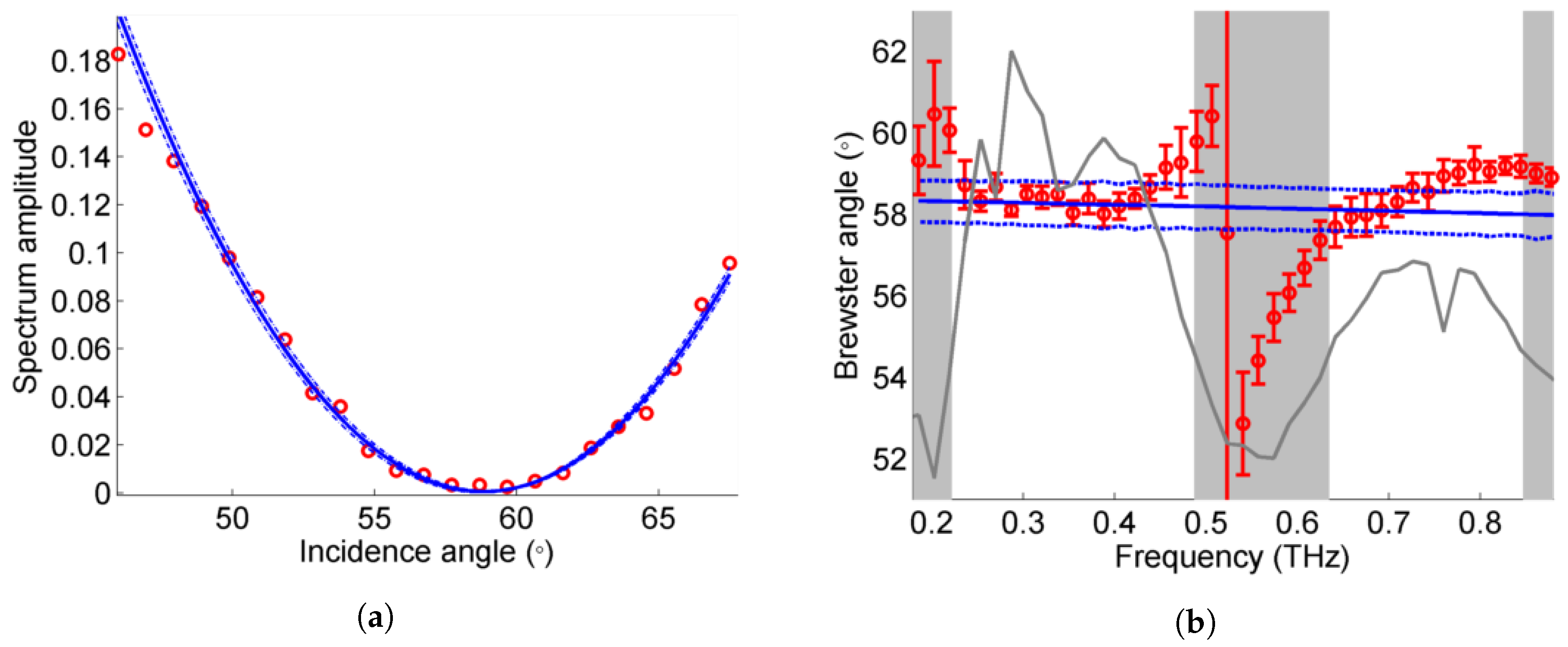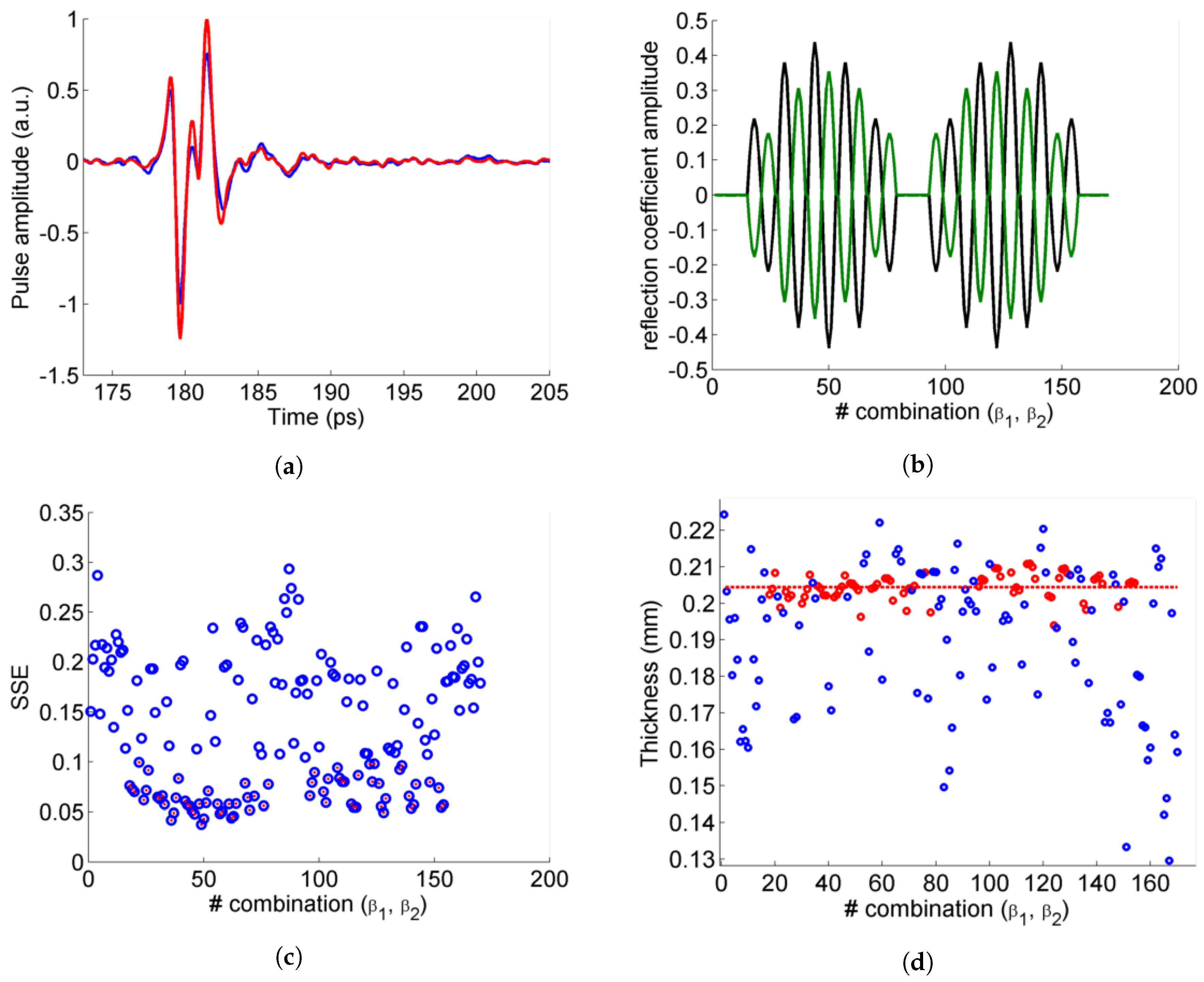Terahertz Time-Domain Polarimetry in Reflection for Film Characterization
Abstract
1. Introduction
2. Materials & Methods
2.1. Setup Configuration
2.2. Optics and Sample Alignments
2.3. Polyvinyl Chloride Film
2.4. Refractive Index Measurement
2.5. Film Thickness Evaluation
2.6. Transmission Spectroscopy
3. Results
3.1. Reflective THz-TDS Polarimetry Setup
3.2. Refractive Index
3.3. Film Thickness
4. Discussion
5. Conclusions
Author Contributions
Funding
Conflicts of Interest
Abbreviations
| ATR | attenuated total reflectance |
| FTIR | Fourier-transformed infrared spectroscopy |
| OCT | optical coherence tomography |
| PCA | photo-conductive antenna |
| PMMA | poly(methyl methacrylate) |
| PS | polystyrene |
| PVC | polyvinyl chloride |
| PVDF | polyvinylidene fluoride |
| SSE | sum of squared estimate of errors |
| TDS | time-domain spectroscopy |
| THz | terahertz |
| UV | ultraviolet |
| vis | visible |
Appendix A
References
- Cheung, K.P.; Auston, D.H. A novel technique for measuring far-infrared absorption and dispersion. Infrared Phys. 1986, 26, 23–27. [Google Scholar] [CrossRef]
- Jepsen, P.U.; Cooke, D.G.; Koch, M. Terahertz spectroscopy and imaging—Modern techniques and applications. Laser Photon. Rev. 2011, 5, 124–166. [Google Scholar] [CrossRef]
- Joyce, H.J.; Boland, J.L.; Davies, C.L.; Baig, S.A.; Johnston, M.B. A review of the electrical properties of semiconductor nanowires: Insights gained from terahertz conductivity spectroscopy. Semicon. Sci. Technol. 2016, 31, 103003. [Google Scholar] [CrossRef]
- Abdul-Munaim, A.M.; Ornik, J.; Koch, M.; Watson, D.G. Terahertz Time Domain Spectroscopy to Detect Different Oxidation Levels of Diesel Engine Oil. Lubricants 2019, 7, 18. [Google Scholar] [CrossRef]
- Farman, N.; Mumtaz, M.; Mahmood, M.A.; Khan, S.D.; Zia, M.A.; Raffi, M.; Ahmed, M.; Ahmad, I. Investigation of optical and dielectric properties of polyvinyl chloride and polystyrene blends in terahertz regime. Opt. Mater. 2020, 99, 109534. [Google Scholar] [CrossRef]
- Neu, J.; Schmuttenmaer, C.A. Tutorial: An introduction to terahertz time domain spectroscopy (THz-TDS). J. Appl. Phys. 2018, 124, 231101. [Google Scholar] [CrossRef]
- Duvillaret, L.; Garet, F.; Coutaz, J.L. Highly precise determination of optical constants and sample thickness in terahertz time-domain spectroscopy. Appl. Opt. 1999, 38, 409–415. [Google Scholar] [CrossRef]
- Wu, D.; Haude, C.; Burger, R.; Peters, O. Application of terahertz time domain spectroscopy for NDT of oxide-oxide ceramic matrix composites. Infrared Phys. Technol. 2019, 102, 102995. [Google Scholar] [CrossRef]
- Ahi, K.; Shahbazmohamadi, S.; Asadizanjani, N. Quality control and authentication of packaged integrated circuits using enhanced-spatial-resolution terahertz time-domain spectroscopy and imaging. Opt. Lasers Eng. 2018, 104, 274–278. [Google Scholar] [CrossRef]
- Pfeiffer, T.; Weber, S.; Klier, J.; Bachtler, S.; Molter, D.; Jonuscheit, J.; Freymann, G.V. Terahertz thickness determination with interferometric vibration correction for industrial applications. Opt. Express 2018, 26, 12558–12568. [Google Scholar] [CrossRef]
- Katletz, S.; Pfleger, M.; Pühringer, H.; Mikulics, M.; Vieweg, N.; Peters, O.; Scherger, B.; Scheller, M.; Koch, M.; Wiesauer, K. Polarization sensitive terahertz imaging: Detection of birefringence and optical axis. Opt. Express 2012, 21, 23025–23035. [Google Scholar] [CrossRef] [PubMed]
- Nashima, S.; Morikawa, O.; Takata, K.; Hangyo, M. Measurement of optical properties of highly doped silicon by terahertz time domain reflection spectroscopy. Appl. Phys. Lett. 2001, 79, 3923. [Google Scholar] [CrossRef]
- Pashkin, A.; Kempa, M.; Němec, H.; Kadlec, F.; Kužel, P. Phase-sensitive time-domain terahertz reflection spectroscopy. Rev. Sci. Instrum. 2003, 74, 4711–4717. [Google Scholar] [CrossRef]
- Ino, Y.; Héroux, J.B.; Mukaiyama, T.; Kuwata-Gonokami, M. Reflection-type pulsed terahertz imaging with a phase-retrieval algorithm. Appl. Phys. Lett. 2006, 88, 041114. [Google Scholar] [CrossRef]
- Zhong, H.; Zhang, C.; Zhang, L.; Zhao, Y.; Zhang, X.C. A phase feature extraction technique for terahertz reflection spectroscopy. Appl. Phys. Lett. 2008, 92, 221106. [Google Scholar] [CrossRef]
- Huang, S.; Ashworth, P.C.; Kan, K.W.C.; Chen, Y.; Wallace, V.P.; Zhang, Y.; Pickwell-MacPherson, E. Improved sample characterization in terahertz reflection imaging and spectroscopy. Opt. Express 2009, 19, 3848–3854. [Google Scholar] [CrossRef] [PubMed]
- Jepsen, P.U.; Jensen, J.K.; Møller, U. Characterization of aqueous alcohol solutions in bottles with THz reflection spectroscopy. Opt. Express 2008, 16, 9318–9331. [Google Scholar] [CrossRef]
- Matsumoto, N.; Hosokura, T.; Nagashima, T.; Hangyo, M. Measurement of the dielectric constant of thin films by terahertz time-domain spectroscopic ellipsometry. Opt. Lett. 2011, 36, 265–267. [Google Scholar] [CrossRef]
- Jeon, T.I.; Grischkowsky, D. Characterization of optically dense, doped semiconductors by reflection THz time domain spectroscopy. Appl. Phys. Lett. 1998, 72, 3032. [Google Scholar] [CrossRef]
- Neshat, M.; Armitage, N. Terahertz time-domain spectroscopic ellipsometry: Instrumentation and calibration. Opt. Express 2012, 20, 29063–29075. [Google Scholar] [CrossRef]
- Pawluczyk, R. Modified Brewster angle technique for the measurement of the refractive index of a DCG layer. Appl. Opt. 1990, 29, 589–592. [Google Scholar] [CrossRef] [PubMed]
- Akimoto, M.; Gekka, Y. Brewster and Pseudo-Brewster Angle Technique for Determination of Optical Constants. Jpn. J. Appl. Phys. 1992, 31, 120–122. [Google Scholar] [CrossRef]
- Wu, Q.H.; Hodgkinson, I. Precision of Brewster-angle methods for optical thin films. J. Opt. Soc. Am. A 1993, 10, 2072–2075. [Google Scholar] [CrossRef]
- Li, M.; Cho, G.C.; Lu, T.M.; Zhang, X.C.; Wang, S.Q.; Kennedy, J.T. Time-domain dielectric constant measurement of thin film in GHz–THz frequency range near the Brewster angle. Appl. Phys. Lett. 1999, 74, 2113. [Google Scholar] [CrossRef]
- Cai, Y.; Brener, I.; Lopata, J.; Wynn, J.; Pfeiffer, L.; Federici, J. Design and performance of singular electric field terahertz photoconducting antennas. Appl. Phys. Lett 1997, 71, 2076–2078. [Google Scholar] [CrossRef]
- Hecht, E. Optics; Addison-Wesley: Boston, MA, USA, 2002; pp. 113–122. [Google Scholar]
- Bahrim, C.; Hsu, W.T. Precise measurements of the refractive indices for dielectrics using an improved Brewster angle method. Am. J. Phys. 2009, 77, 337–343. [Google Scholar] [CrossRef]
- TeraLyzer Data Extraction Suite, Lytera UG. Available online: http://www.lytera.com (accessed on 9 June 2020).
- Scheller, M.; Koch, M. Fast and Accurate Thickness Determination of Unknown Materials using Terahertz Time Domain Spectroscopy. J. Infrared Millim. Terahertz Waves 2009, 30, 762–769. [Google Scholar] [CrossRef]
- Garet, F.; Duvillaret, L.; Coutaz, J.L. Evidence of frequency-dependent THz beam polarization in time-domain spectroscopy. SPIE Proc. 1999, 3617, 30–37. [Google Scholar]
- Gong, Y.; Dong, H.; Chen, Z. Cross-polarization Response of a Two-contact Photoconductive Terahertz Detector. IEEE Proc. THz Sci. Tech. 2011, 4, 137–148. [Google Scholar]
- Pfleger, M.; Roitner, H.; Pühringer, H.; Wiesauer, K.; Grün, H.; Katletz, S. Advanced birefringence measurements in standard terahertz time-domain spectroscopy. Appl. Opt. 2014, 53, 3183–3190. [Google Scholar] [CrossRef]
- Chen, X.; Parrott, E.P.J.; Huang, Z.; Chan, H.P.; Pickwell-MacPherson, E. Robust and accurate terahertz time-domain spectroscopic ellipsometry. Phot. Res. 2018, 6, 768–775. [Google Scholar] [CrossRef]
- Faridi, F.R.; Nandi, U.; Preu, S. 1.5 Port Vector Spectrometer for Terahertz Time Domain Spectroscopy. In Proceedings of the 2018 43rd International Conference on Infrared, Millimeter, and Terahertz Waves (IRMMW-THz), Nagoya, Japan, 9–14 September 2018; pp. 1–2. [Google Scholar]
- Jin, Y.S.; Kim, G.Y.; Jeon, S.G. Terahertz Dielectric Properties of Polymers Yun-Sik. J. Korean Phys. Soc. 2006, 49, 513–517. [Google Scholar]
- Jansen, C.; Wietzke, S.; Wang, H.; Koch, M.; Zhao, G. Terahertz spectroscopy on adhesive bonds. Polym. Test. 2011, 30, 150–154. [Google Scholar] [CrossRef]
- Withayachumnankul, W.; Fischer, B.M.; Abbott, D. Material thickness optimization for transmission-mode terahertz time-domain spectroscopy. Opt. Express 2008, 16, 7382–7396. [Google Scholar] [CrossRef] [PubMed]
- Hunter, W.R. Measurement of optical properties of materials in the vacuum ultraviolet spectral region. Appl. Opt. 1982, 21, 2103–2114. [Google Scholar] [CrossRef]
- Ding, S.; Li, Q.; Yao, R.; Wang, Q. Brewster’s angle method for absorption coefficient measurement of high-resistivity silicon based on CW THz laser. Appl. Phys. B 2009, 98, 119–124. [Google Scholar] [CrossRef]
- Ogusu, K.; Suzuki, K.; Nishio, H. Simple and accurate measurement of the absorption coefficient of an absorbing plate by use of the Brewster angle. Opt. Lett. 2006, 31, 909–911. [Google Scholar] [CrossRef] [PubMed]





© 2020 by the authors. Licensee MDPI, Basel, Switzerland. This article is an open access article distributed under the terms and conditions of the Creative Commons Attribution (CC BY) license (http://creativecommons.org/licenses/by/4.0/).
Share and Cite
van Frank, S.; Leiss-Holzinger, E.; Pfleger, M.; Rankl, C. Terahertz Time-Domain Polarimetry in Reflection for Film Characterization. Sensors 2020, 20, 3352. https://doi.org/10.3390/s20123352
van Frank S, Leiss-Holzinger E, Pfleger M, Rankl C. Terahertz Time-Domain Polarimetry in Reflection for Film Characterization. Sensors. 2020; 20(12):3352. https://doi.org/10.3390/s20123352
Chicago/Turabian Stylevan Frank, Sandrine, Elisabeth Leiss-Holzinger, Michael Pfleger, and Christian Rankl. 2020. "Terahertz Time-Domain Polarimetry in Reflection for Film Characterization" Sensors 20, no. 12: 3352. https://doi.org/10.3390/s20123352
APA Stylevan Frank, S., Leiss-Holzinger, E., Pfleger, M., & Rankl, C. (2020). Terahertz Time-Domain Polarimetry in Reflection for Film Characterization. Sensors, 20(12), 3352. https://doi.org/10.3390/s20123352




